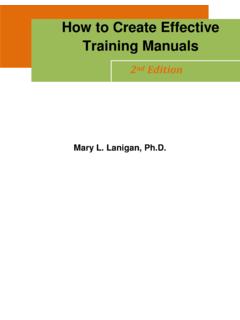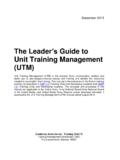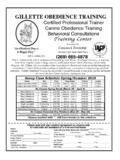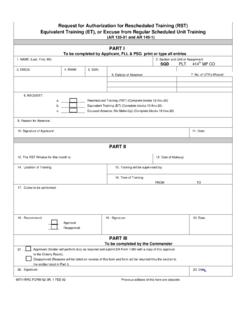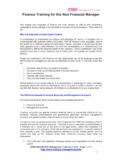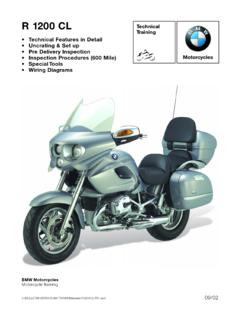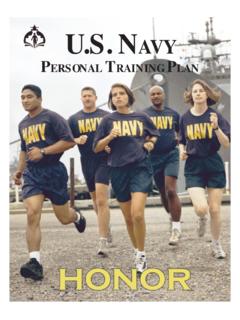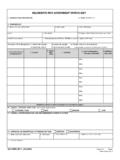Transcription of How to Create Effective Training Manuals - hpandt.com
1 Mary L. Lanigan, How to Create Effective Training Manuals 1 How to Create Effective Training Manuals Mary L. Lanigan, Third House, Inc. Tinley Park, Illinois 60477 2 How to Create Effective Training Manuals Copyright 2010 by Third House Inc. Third House Inc. Box 1245 Tinley Park, Illinois 60477 All rights reserved. No part of this manual may be photocopied or reproduced in any form without written permission from the publisher. Moreover, no part of this publication can be stored in a retrieval system, transmitted by any means, or recorded or otherwise, without written permission from the publisher. Limits of Liability and Disclaimer of Warranty While every precaution has been taken in preparing this manual , including research, development, and testing, the Publisher and Author assume no responsibility for errors or omissions.
2 No liability is assumed by either Publisher or Author for damages resulting in the use of this information. Printed in the United States of America 3 Table of Contents Welcome 4 Introduction 5 Objectives 5 Outline 5 Background Information 6 Step 1: Complete a Front-end Analysis 6 Step 2: Divide the Content into Modules 6 Step 3: Select a Style manual 7 Creating the Training manual 8 Chunk Material and use Transitions 8 Writing is Easy to Read 11 Leave White Space 11 Use Images 11 Use Bullets 11 Visually Appealing 12 Provide Practice 12 Edit the Draft Training manual 13 Finalize the Training manual 13 Front Contents 13 Back Contents 17 Binding 19 Summary 21 Appendix 22 References 26 4 Welcome These guidelines have been written for a Training context in which a Training manual will be the main delivery source for the educational experience.
3 The manual will neither compliment a stand-up trainer nor will it be downloaded from an Internet Training session. Instead, this Training manual will be used as a self-study tool. W hile most of the guidelines also hold true for a Training manual that compliments a stand-up or Internet delivered Training , the focus of these guidelines is on a self-study manual . For more information about an instructor-led manual , see the Appendix. Pre-requisite Skills This manual is written for an audience that already is familiar with front-end analyses. You should know, at the very least, how to carry out a task listing and how to construct a structured lesson. You should also have the skills to do screen captures, usability testing, and creating documents in W ord software.
4 5 Introduction The purpose of this manual is to guide instructional designers on how to Create Effective Training Manuals . The benefit of learning this information is to Create professional looking educational tools that will serve your clients well. It is important to implement the information within this manual in order move your clients to optimal levels of performances. Objectives At the end of this lesson, you will be able to: Write a Training manual ; Edit a Training manual ; and, Appropriately bind a Training manual . Outline Complete a Front-end Analysis Divide the Contents into Modules Select a Style manual Creating a Training manual Edit a Training manual Bind a Training manual Introduction 6 There are three steps you should take before composing your Training manual .
5 These steps are similar to designing any other performance improvement intervention. Step 1: Complete a Front-end Analysis Before writing a Training manual , you should have completed some type of front-end analysis, including task analysis. By doing so, you will have created, at the very least, a task listing of terminal and enabling objectives for the cognitive and behavioral tasks you plan to teach within the Training manual . You should also have a list of performance objectives that manifested from the task listing. The task listing and performance objectives will guide the outline of your Training manual . The outline should follow the task listing in the sense that all pre-requisite skills should be presented before more advanced skills.
6 Step 2: Divide the Content of Your Training into Modules or Chapters After outlining the content domain of your Training , divide the content of your Training into modules or chapters. Each module will then be set-up as a structured lesson. Steps to Creating Effective Training Manuals Background Information 7 Step 3: Select a Style manual and Prepare a Style Sheet to Ensure Consistency There are a few style Manuals to select from such as the American Psychological Association (APA), the Modern Language Association (MLA), and the Chicago manual of Style. All three of these Manuals offer extensive guidelines on how to present information, including how to cite rights and permission, grammar and usage, punctuation, spelling, names, numbers, foreign language, quotes, illustrations, tables, math, abbreviations, references, indexes, and more.
7 A style sheet helps the writer ensure that the Training manual looks consistent. For example, if the main headings are Arial, 14 point font and the sub-headings are Arial 12 point font, then all main and sub-headings should follow suit. The manual would look less professional if some of the headings were Arial 14 while others were Times New Roman 12, or if the sub-headings were listed in various font sizes from 10 to 18. Besides listing heading sizes, the style sheet notes the rules the writers and editors will follow. For example, if there is special punctuation used or unusual terminology, then the style sheet would note the guidelines to follow for these cases. 8 Step 1: Write the draft of the Training manual W hen writing your draft manual , implement the following tips.
8 A. Chunk material into shorter; albeit logical, sections. Connect sections with transitions. Trainees will be overwhelmed by huge amounts of text group together. To reduce their anxiety and engage them in your Training materials, Create shorter paragraphs. Place the paragraphs in logical order. As you present your information, you want to chunk your ideas into units or what would be in writing, a paragraph. A paragraph typically possesses four elements. 1. A main idea. 2. An explanation of the main idea, , the presenter s rationale. 3. Examples and/or non-examples to illustrate the explanation. 4. A completion of the idea and transition into the next topic. EXAMPLE Innovative Practices for Needs Assessors* Needs assessment is one of the most important processes to implement before activating any intervention.
9 Surveys, focus groups and interviews are the traditional assessment apparatus used to uncover performance gaps. To utilize these tools optimally, blind obedience to what has been done in the past can sabotage present objectives; and instead, implementing contemporary ideas is paramount. This presentation introduces innovative practices which were executed during a needs assessment to determine if building a health center was essential to an Illinois community were loss school days and emergency room visits were costly. Creating the Training manual 9 In additional to presenting ideas in cohesive chunks, incorporating Effective transitional statements will help your audience better understand how you are moving from one idea to the next.
10 Transitions are frequently made up of transitional devices. A transitional device cues the listeners to a connection between thoughts. Below are some examples. Transition Devices Example Words Used Addition and, in addition to, furthermore, moreover, besides, too, also, another, equally important, first, second, etc., again, further, next, likewise, similarly, in the same way Illustration thus, for example, for instance, namely, to illustrate, in other words, in particular, specifically, such as Emphasis above all, of course, certainly, surely, in fact, really, in truth, again, besides, also, furthermore, in addition Examples for example, for instance, to illustrate, thus, in other words, as an illustration, in particular Suggestion for this purpose, to this end, with this in mind, therefore Summary therefore, finally, consequently, thus, in conclusion, in brief, as a result 10 If you are doing a procedural manual like this one, then make sure the steps are in logical order.
